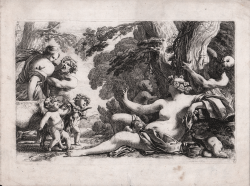




| Reference: | S42021 |
| Author | Michel Dorigny |
| Year: | 1650 ca. |
| Measures: | 300 x 196 mm |



| Reference: | S42021 |
| Author | Michel Dorigny |
| Year: | 1650 ca. |
| Measures: | 300 x 196 mm |
Etching and engraving, 1650 circa, numbered 11 at lower left.
After training for five years under Georges Lallemand in Paris, Michel Dorigny soon joined the circle around the painter, Simon Vouet, with whom he struck up a close and lasting friendship. Dorigny subsequently became one of the main printmaking interpreters of Vouet’s painted oeuvre and was also involved as a painter in several of the master’s artistic projects. His prints include works on religious and mythological themes as well as individual prints and series on Dionysian topics.
It is to this latter category that six etchings belong which Dorigny produced together with Nicolas Chaperon and other artists for the series entitled Recueil de diverses Bacchanales (Robert-Dumesnil, vol. IV, p. 254, nos. 12–17). All the prints in the series contain the addresses of the respective publishers but not the names of the designers and engravers, which makes it difficult to definitively ascribe the works to specific artists. The prints were probably first issued by the publishers François Langlois, known as ‘il Ciartres’ (1589 Chartres – 1647 Paris), and Philippe Huart (active around 1639–1648) and were followed by a second edition published by Pierre Mariette. The designs for the etchings may well stem from Nicolas Chaperon or from Dorigny himself.
Another suite of six bacchanals (Robert – Dusmenil 6-11) bears on each plate the name of D’Origny as engraver. Both suites probably date to the 1650 when, after Vouet’s death, Dorigny became one of the most important decorative painters in Paris.
Focused on the activities of Bacchus, Silenus, and their merry band of associates, these two etched sets of charming compositions demonstrate the wealth and dexterity of Dorigny's powers of invention. In contrast to most of his earlier interpretations of the works of Vouet and others, where he often used engraving to lightly augment his vigorous etching (see cat. 102), some of Dorigny's later prints, espe- cially these two suites of bacchanals, rely even more on engraving. This trend parallels a gradual shift in his draftsmanship, which reveals an increasing tendency towards pronounced contours and more sculptural figures.
A fine impression, printed with tone on contemporary laid paper, with margins, very good condition.
Bibliografia
Robert-Dusmenil, IV, p. 254, 14: Reed, French Prints from the Age of the Musketeers, p. 233.
Michel Dorigny(Saint-Quentin 1616 – Parigi 1665)
Michel Dorigny(Saint-Quentin 1616 – Parigi 1665)